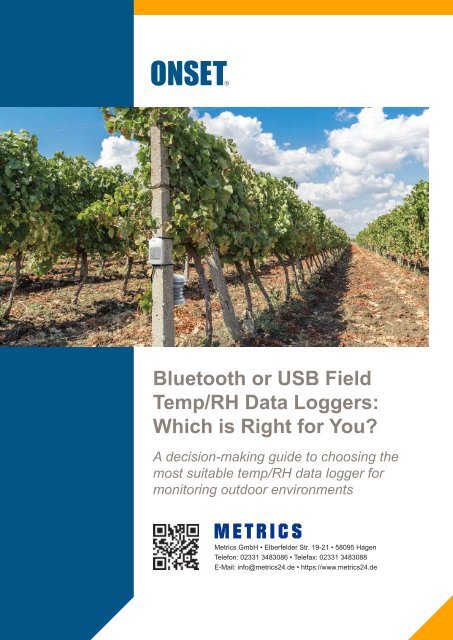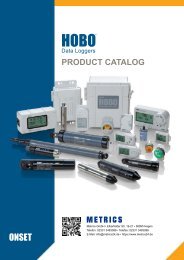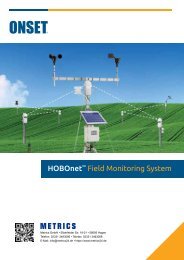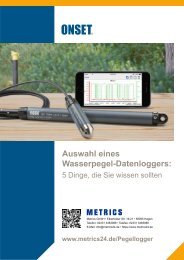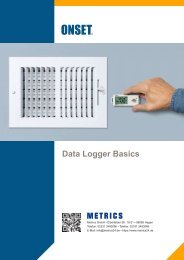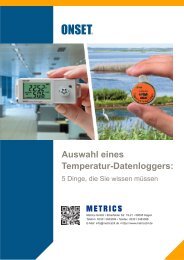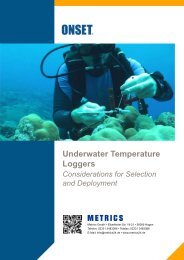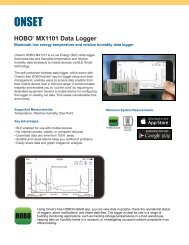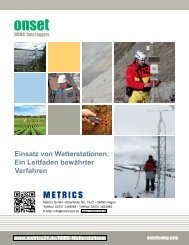Onset Guide: Bluetooth or USB Field Temp/RH Data Loggers
HOBO U23- oder MX2300-Serie Datenlogger? Onsets Ratgeber gibt Entscheidungshilfen zur Auswahl des geeignetsten Outdoor-Datenloggers für Temperatur bzw. Temperatur und relative Feuchte (englisch).
HOBO U23- oder MX2300-Serie Datenlogger? Onsets Ratgeber gibt Entscheidungshilfen zur Auswahl des geeignetsten Outdoor-Datenloggers für Temperatur bzw. Temperatur und relative Feuchte (englisch).
Create successful ePaper yourself
Turn your PDF publications into a flip-book with our unique Google optimized e-Paper software.
<strong>Bluetooth</strong> <strong>or</strong> <strong>USB</strong> <strong>Field</strong><br />
<strong>Temp</strong>/<strong>RH</strong> <strong>Data</strong> <strong>Loggers</strong>:<br />
Which is Right f<strong>or</strong> You?<br />
A decision-making guide to choosing the<br />
most suitable temp/<strong>RH</strong> data logger f<strong>or</strong><br />
monit<strong>or</strong>ing outdo<strong>or</strong> environments<br />
Metrics GmbH • Elberfelder Str. 19-21 • 58095 Hagen<br />
Telefon: 02331 3483086 • Telefax: 02331 3483088<br />
E-Mail: info@metrics24.de • https://www.metrics24.de
Introduction<br />
Common to most outdo<strong>or</strong><br />
field research is the need to<br />
systematically collect vital<br />
temperature and relative<br />
humidity (<strong>RH</strong>) data that<br />
can be used to f<strong>or</strong>mulate<br />
results and shape<br />
conclusions.<br />
<strong>Field</strong> research conducted in outdo<strong>or</strong> environments comprises a diversity of<br />
methods and inc<strong>or</strong>p<strong>or</strong>ates several disciplines and scientific areas. Typical<br />
areas of study are agricultural research, f<strong>or</strong>estry surveys, and ecological<br />
investigations. Common to most outdo<strong>or</strong> field research is the need to<br />
systematically collect vital temperature and relative humidity (<strong>RH</strong>) data that<br />
can be used to f<strong>or</strong>mulate results and shape conclusions.<br />
In the field of ecology, f<strong>or</strong> example, data obtained from outdo<strong>or</strong> field research<br />
allows investigat<strong>or</strong>s to better understand how natural systems respond to<br />
changing environmental conditions, providing insights f<strong>or</strong> better protecting<br />
valuable ecosystems. Likewise, data obtained from outdo<strong>or</strong> research can<br />
provide environmental scientists with the means to analyze natural processes<br />
and evaluate the impacts of human actions on the environment. Additionally,<br />
data gathered from outdo<strong>or</strong> field research can be used to help improve<br />
agricultural practices, leading to m<strong>or</strong>e sustainable growing methods, higher<br />
crop qualities, and greater productivity.<br />
To ensure th<strong>or</strong>ough and accurate results—and rig<strong>or</strong>ous investigative<br />
conclusions—emphasis in outdo<strong>or</strong> field research needs to be placed on the<br />
collection of quality data. F<strong>or</strong> this reason, the use of robust and effective<br />
monit<strong>or</strong>ing instruments is a very imp<strong>or</strong>tant consideration.<br />
<strong>Data</strong> loggers that measure field temperature and <strong>RH</strong> are vital tools f<strong>or</strong><br />
supp<strong>or</strong>ting eff<strong>or</strong>ts in this field. Offering the capacity to automatically collect<br />
data on a 24-hour basis, field temp/<strong>RH</strong> data loggers are deployed in<br />
outdo<strong>or</strong> locations to measure and rec<strong>or</strong>d inf<strong>or</strong>mation over time, providing a<br />
comprehensive and accurate picture of changing environmental conditions.<br />
Generally, two categ<strong>or</strong>ies of field temp/<strong>RH</strong> data<br />
loggers are available on the market: traditional <strong>USB</strong><br />
options and newer models that utilize <strong>Bluetooth</strong><br />
technology.<br />
2<br />
With <strong>USB</strong> field temp/<strong>RH</strong> data loggers, users must<br />
physically connect the data logger to the <strong>USB</strong> p<strong>or</strong>t<br />
of a computer <strong>or</strong> handheld device (a shuttle) to<br />
retrieve and download data—a task that is often<br />
routine, but one that can also become burdensome<br />
<strong>or</strong> challenging, depending on the environment <strong>or</strong> the<br />
specific location where the data logger is deployed.<br />
<strong>USB</strong> loggers can have either a <strong>USB</strong> connect<strong>or</strong> built<br />
into them, <strong>or</strong> some other f<strong>or</strong>m of communication<br />
such as optical, in which case they use a base<br />
station that plugs into a <strong>USB</strong> p<strong>or</strong>t in the computer. Because loggers with<br />
optical communication don’t have electrical connections, which can be<br />
unreliable in the field, they can provide better reliability in field applications<br />
than loggers with <strong>USB</strong> connect<strong>or</strong>s. If you are looking at loggers with optical<br />
communication, look f<strong>or</strong> ones that can w<strong>or</strong>k with an optical data shuttle to<br />
offload data, without having to take a laptop into the field.
<strong>Data</strong> loggers with <strong>Bluetooth</strong> communication allow<br />
data to be transferred wirelessly to a mobile<br />
device. When looking at <strong>Bluetooth</strong> data loggers,<br />
keep in mind that there are different versions<br />
of <strong>Bluetooth</strong>. <strong>Loggers</strong> that use older versions<br />
of <strong>Bluetooth</strong> require “pairing” with the mobile<br />
devices, which means having to push a button on<br />
the logger to enable communications between it<br />
and the mobile device. This may not be practical<br />
f<strong>or</strong> loggers in hard-to-access locations.<br />
<strong>Data</strong> loggers with <strong>Bluetooth</strong> Low Energy (BLE)<br />
technology, also known as <strong>Bluetooth</strong> Smart<br />
<strong>or</strong> <strong>Bluetooth</strong> 4.0, allow data to be transferred<br />
wirelessly without having to connect cables <strong>or</strong><br />
push a button on the logger. This means that you do not have to physically<br />
access the logger to offload data. Instead, you simply use an app on your<br />
mobile device to connect to any logger within range. The time savings when<br />
deploying loggers <strong>or</strong> retrieving data can be dramatic.<br />
BLE is particularly well-suited to data loggers, as it uses less battery power.<br />
In addition, with a well-written app, <strong>Bluetooth</strong> loggers allow you to take<br />
advantage of the power and connectivity of today’s smartphones and other<br />
mobile devices.<br />
The purpose of this white paper is to provide an unbiased comparison of<br />
<strong>USB</strong> and BLE field temp/<strong>RH</strong> data loggers f<strong>or</strong> outdo<strong>or</strong> field research. In doing<br />
so, this analysis will seek to offer practical advice and objective guidance f<strong>or</strong><br />
determining which option is best f<strong>or</strong> your unique application.<br />
3
Imp<strong>or</strong>tant features to consider in temp/<strong>RH</strong> data loggers<br />
Bef<strong>or</strong>e examining the primary considerations that will help drive a decision<br />
between <strong>USB</strong> and BLE options, it’s imp<strong>or</strong>tant to think about the key features<br />
and capabilities of field temp/<strong>RH</strong> loggers in general, regardless of whether<br />
they are <strong>USB</strong> <strong>or</strong> BLE.<br />
User-replaceable battery<br />
With field temp/<strong>RH</strong> data loggers that have this option, the existing battery can<br />
be swapped out with a new one. The ability to replace the battery eliminates<br />
the need to purchase a new logger when the <strong>or</strong>iginal battery dies.<br />
Measurement accuracy<br />
It’s critical to ensure that the logger will meet your accuracy requirements.<br />
The HOBO U23 <strong>Temp</strong>erature/<strong>RH</strong><br />
<strong>Data</strong> Logger offers convenient<br />
user-replaceable battery.<br />
• Keep in mind that accuracy is typically specified as +/-X. This means<br />
that f<strong>or</strong> two loggers measuring the same temperature <strong>or</strong> <strong>RH</strong>, one could<br />
be reading low by that amount, while the other reads high, so that<br />
they could provide readings that are twice the accuracy spec apart.<br />
F<strong>or</strong> example, if the spec is +/- 0.5C, the readings from two loggers<br />
measuring the same temp could be 1.0C apart. This is especially<br />
imp<strong>or</strong>tant to keep in mind if you’re comparing data between loggers<br />
deployed at different locations.<br />
• You should also consider sens<strong>or</strong> drift over time, and the response time<br />
of the logger to changing conditions, as these fact<strong>or</strong>s can also affect the<br />
accuracy of measurements.<br />
• In addition, radiation heating from sunlight can cause artificially high<br />
readings. Please refer to the section on solar radiation shields later in<br />
this document.<br />
Alarm notifications<br />
A visual alarm is a valuable feature in that it alerts users that out-of-range<br />
conditions occurred. The user sets the temperature <strong>or</strong> humidity thresholds<br />
when the logger is configured.<br />
Above photo shows the MX2304 external<br />
temperature data logger with an alarm status,<br />
indicating a set temperature threshold has been<br />
exceeded.<br />
• Do you need to be notified of the alarm immediately? If so, you need<br />
a logger that notifies you, and this is usually accomplished through<br />
the internet and a web-connected logger, which has cellular, Wi-Fi, <strong>or</strong><br />
Ethernet.<br />
• Alternatively, if there will be people on site who can check f<strong>or</strong> alarms, a<br />
visual alarm on the logger <strong>or</strong> in the mobile app may w<strong>or</strong>k.<br />
• In some cases you may just want to know that an alarm condition<br />
happened during the deployment, so you know to take a closer look at<br />
the data.<br />
• Alarms can be especially useful in shipping applications where you want<br />
to be sure that conditions did not get too hot/cold during transp<strong>or</strong>t.<br />
4
Logging Modes<br />
Besides the standard fixed-rate logging, determine whether you need any<br />
special logging modes such as: Wrap-when-full, Push-button start <strong>or</strong> stop,<br />
Time-date stop, Burst logging, <strong>or</strong> Statistics logging.<br />
Mounting mechanisms<br />
Look f<strong>or</strong> a logger that can be easily mounted in your field sites.<br />
Consider how you want to mount your loggers in place:<br />
• Zip-ties are easy, fast, and secure, f<strong>or</strong> speedy field deployments.<br />
• Screws take a little m<strong>or</strong>e time, but are a little m<strong>or</strong>e secure.<br />
• Look f<strong>or</strong> a logger that includes integrated mounting holes f<strong>or</strong> your<br />
preferred mounting method.<br />
• Some loggers come with brackets that allow the logger to be removed<br />
f<strong>or</strong> data download.<br />
Processing data from multiple loggers<br />
If you are deploying several loggers at a time, look f<strong>or</strong> loggers with these timesaving<br />
features:<br />
• Launch time-saving options: This is the ability to define a deployment<br />
configuration once (logging mode, logging rate, start time, etc.) and use<br />
it to configure all the loggers f<strong>or</strong> a deployment without having to re-enter<br />
this inf<strong>or</strong>mation f<strong>or</strong> each logger.<br />
• Bulk-exp<strong>or</strong>t <strong>or</strong> bulk-share option: This is the ability to select multiple files<br />
and exp<strong>or</strong>t <strong>or</strong> share them all at once.<br />
• Automatic upload option: This is the ability f<strong>or</strong> the software to<br />
automatically merge data into a web database when the device <strong>or</strong><br />
computer is connected to the internet.<br />
Phone screen capture above shows the<br />
Configure settings in HOBOmobile f<strong>or</strong> the<br />
MX2301 temperature/relative humidity<br />
data logger<br />
5
Key aspects to consider between BLE and <strong>USB</strong> field<br />
temp/<strong>RH</strong> data loggers<br />
With BLE temp/<strong>RH</strong> loggers,<br />
users can quickly and<br />
seamlessly transmit<br />
data wirelessly to mobile<br />
devices from up to 100 feet<br />
away, without coming into<br />
physical contact with the<br />
logger<br />
F<strong>or</strong> users weighing both BLE and <strong>USB</strong> field temp/<strong>RH</strong> data logger options,<br />
a range of imp<strong>or</strong>tant fact<strong>or</strong>s should be considered. The following topics<br />
represent key drivers to evaluate when deciding which option is m<strong>or</strong>e<br />
appropriate.<br />
F<strong>or</strong> existing users currently employing <strong>USB</strong> field temp/<strong>RH</strong> data loggers,<br />
changing up equipment schemes to switch over to BLE can be a difficult<br />
proposition. Many users may not necessarily feel a need to upgrade to newer<br />
BLE technology. And continuing with the same technology means using the<br />
base stations and software you already have, and not having to use two sets<br />
of software and communication devices in the field.<br />
Nevertheless, given the potential to significantly streamline both data logger<br />
deployment and data retrieval in the field, the convenience and advantages<br />
offered by BLE can be significant.<br />
<strong>Data</strong> access<br />
F<strong>or</strong> outdo<strong>or</strong> field monit<strong>or</strong>ing, data access can<br />
be a critical issue—especially in applications<br />
where data loggers need to be deployed in hardto-reach<br />
<strong>or</strong> limited-access locations. In these<br />
situations, <strong>USB</strong> temp/<strong>RH</strong> data loggers—due to<br />
the need to physically connect to a computer <strong>or</strong><br />
handheld device in <strong>or</strong>der to download data—can<br />
be m<strong>or</strong>e difficult to w<strong>or</strong>k with.<br />
The above illustration depicts using a mobile<br />
device to easily download data from a BLE<br />
data logger in a hard-to-reach location.<br />
With BLE temp/<strong>RH</strong> loggers, users can quickly<br />
and seamlessly transmit data wirelessly to<br />
mobile devices from up to 100 feet away, without<br />
coming into physical contact with the logger, thus<br />
overcoming many of the logistical challenges associated with downloading<br />
data from limited-access areas. Some examples where BLE temp/<strong>RH</strong> loggers<br />
can be beneficial include:<br />
• Critical <strong>or</strong> endangered habitats<br />
• Bird nests<br />
• Tree canopies<br />
• Crop fields<br />
• Human-confined spaces that might present a safety issue<br />
• Bat caves (where bats could be disturbed)<br />
• Environmental chambers that could be compromised if opened<br />
• Rooftops and green roofs<br />
• HVAC studies <strong>or</strong> energy-auditing applications that require site-specific<br />
outdo<strong>or</strong> temperatures (data from a BLE logger placed on the outside<br />
could be obtained from inside a building)<br />
6
<strong>Data</strong> sharing<br />
Because of the power of today’s mobile devices, BLE data loggers that w<strong>or</strong>k<br />
with them provide greater flexibility and convenience in terms of where data<br />
can be transmitted and how it can be shared. The logger app on a mobile<br />
device can easily convert data into Excel <strong>or</strong> text files, and it lets you download<br />
and send data in a few simple steps. The logger apps can w<strong>or</strong>k with other<br />
apps on the mobile device to share these files via email, messaging, <strong>or</strong> Google<br />
Drive, <strong>or</strong> automatically upload data to web databases, like <strong>Onset</strong>’s HOBOlink.<br />
And all of this can be done while still in the field, without having to return to<br />
the office to share data. As such, f<strong>or</strong> users who need to share data files <strong>or</strong><br />
measurement data, BLE temp/<strong>RH</strong> data loggers can be the most effective<br />
option.<br />
It is, however, also easy to exp<strong>or</strong>t data from a desktop program to Excel <strong>or</strong><br />
other programs, often with m<strong>or</strong>e powerful f<strong>or</strong>matting options available, such<br />
that the files can be directly opened in the other programs. Desktop software<br />
like HOBOware, f<strong>or</strong> example, provides the ability to customize exp<strong>or</strong>ted data<br />
in terms of international date and decimal f<strong>or</strong>mats. If you will be looking at data<br />
on your own laptop computer, using <strong>USB</strong> loggers that can be directly offloaded<br />
to your laptop can save you the step of having to transfer files later.<br />
Comparing Durability<br />
<strong>Onset</strong>’s BLE options—the HOBO MX<br />
series temperature/<strong>RH</strong> loggers —are<br />
IP67-rated and have housing made of<br />
100% UV-resistant materials.<br />
Durability<br />
When determining the durability of a logger, look f<strong>or</strong> its IP <strong>or</strong> NEMA rating,<br />
and confirm that it’s made from all UV-resistant materials. F<strong>or</strong> outdo<strong>or</strong><br />
deployments, you should use loggers that are rated IP64 <strong>or</strong> higher, <strong>or</strong> NEMA<br />
4 <strong>or</strong> higher. F<strong>or</strong> use in c<strong>or</strong>rosive environments, look f<strong>or</strong> <strong>RH</strong> sens<strong>or</strong>s that are<br />
user-replaceable.<br />
Also keep in mind that loggers requiring electrical connections can be less<br />
reliable in field deployments. Ideally you’d want a logger that can remain<br />
sealed during deployments and data offload. Having to open the logger in the<br />
field can expose electronic circuits to moisture, which can lead to failures.<br />
Generally speaking, the ability f<strong>or</strong> both BLE and <strong>USB</strong> temp/<strong>RH</strong> data loggers<br />
to withstand harsh environmental conditions will vary from manufacturer to<br />
manufacturer. (See sidebar f<strong>or</strong> a comparison of <strong>Onset</strong> temp/<strong>RH</strong> loggers.)<br />
<strong>Onset</strong>’s Optic <strong>USB</strong> options, which<br />
include the HOBO U23 Pro v2 series<br />
temperature/<strong>RH</strong> loggers, use optical<br />
communications in the logger f<strong>or</strong><br />
reliable data download with a base<br />
station <strong>or</strong> data shuttle.<br />
While both are durable, the BLE<br />
option is generally m<strong>or</strong>e robust and<br />
could represent a better choice f<strong>or</strong><br />
monit<strong>or</strong>ing in extreme climates such<br />
as arctic regions, deserts, and coastal<br />
areas.<br />
On the other hand, if you are<br />
monit<strong>or</strong>ing in an environment that’s<br />
c<strong>or</strong>rosive to <strong>RH</strong> sens<strong>or</strong>s—with<br />
high levels of ammonia in the air,<br />
f<strong>or</strong> example—you may want to use<br />
HOBO U23s, as they are equipped<br />
with user-replaceable <strong>RH</strong> sens<strong>or</strong>s.<br />
7
Cost of ownership<br />
Product costs can vary among manufacturers. In general, however, f<strong>or</strong> temp/<br />
<strong>RH</strong> data loggers the BLE option is less expensive f<strong>or</strong> users who need only one<br />
<strong>or</strong> two data loggers. Cost savings are realized because BLE users don’t need<br />
to buy computer software <strong>or</strong> a base station—all they need is the free app to<br />
run on their mobile devices.<br />
F<strong>or</strong> larger studies that involve the purchase of dozens of loggers, however, the<br />
extra cost associated with peripheral equipment required f<strong>or</strong> <strong>USB</strong> temp/<strong>RH</strong><br />
data loggers becomes less of a fact<strong>or</strong>.<br />
Alarm notifications<br />
Both <strong>USB</strong> and BLE loggers can provide alarm notifications. With BLE loggers,<br />
however, the app can highlight which (if any) loggers in the area have<br />
exceeded limits, letting the user offload and review data from those loggers<br />
first.<br />
Radiation shield integration<br />
With many outdo<strong>or</strong> applications, the need to protect data<br />
loggers from direct sunlight is essential in <strong>or</strong>der to prevent<br />
false high readings from heating caused by solar radiation.<br />
Both <strong>USB</strong> and BLE temp/<strong>RH</strong> data loggers have cables/<br />
probes that can easily be placed inside a radiation shield.<br />
BLE options, however, allow users to mount loggers inside<br />
a shield, eliminating the inconvenience of having to remove<br />
the sens<strong>or</strong> from the radiation shield to download data and<br />
then reinstall it...and eliminating the risk of exposed cables<br />
that can be chewed by insects <strong>or</strong> rodents.<br />
The HOBO MX2301 <strong>Temp</strong>erature/Relative<br />
Humidity data logger shown mounted inside<br />
the RS1 Solar Radiation Shield<br />
Conclusion<br />
When choosing temp/<strong>RH</strong> loggers it’s critical to select loggers that meet your<br />
measurement needs and that hold up well in harsh field conditions. Once<br />
these basic requirements are met, you should consider the advantage of BLE<br />
loggers f<strong>or</strong> deploying in hard-to-access locations, where wireless data offload<br />
can save a lot of time and prevent disruption to the environment. And because<br />
they w<strong>or</strong>k with an app on your phone <strong>or</strong> tablet, BLE loggers give you access to<br />
all the convenience and power that today’s mobile devices provide.<br />
8
Other inf<strong>or</strong>mational resources available from <strong>Onset</strong>:<br />
<strong>Data</strong> Logger Basics<br />
In today’s data-driven w<strong>or</strong>ld of satellite uplinks, wireless netw<strong>or</strong>ks,<br />
and the Internet, it is common to hear the terms “data logging” and<br />
“data loggers” and not really have a firm grasp of what they are.<br />
Most people have a vague idea that data logging involves<br />
electronically collecting inf<strong>or</strong>mation about the status of something<br />
in the environment, such as temperature, relative humidity, <strong>or</strong><br />
energy use. They’re right, but that’s just a small view of what data<br />
logging is.<br />
Choosing a Conductivity Logger<br />
Whether you are selecting a conductivity logger f<strong>or</strong> the first time<br />
<strong>or</strong> have experience measuring conductivity, this paper can help<br />
you determine the type of logger that best suits your needs. It<br />
highlights the five most imp<strong>or</strong>tant considerations in selecting<br />
and deploying a conductivity logger: measurement range and<br />
accuracy, other fact<strong>or</strong>s that affect accuracy, ease of deployment<br />
and offload, software capabilities, and cost of ownership.<br />
Choosing a <strong>Temp</strong>erature <strong>Data</strong> Logger<br />
This guide details features to consider when choosing a<br />
temperature data logger, including accuracy requirements, data<br />
access needs, software packages, and power requirements.<br />
Expl<strong>or</strong>e real-w<strong>or</strong>ld application examples that illustrate how users<br />
have inc<strong>or</strong>p<strong>or</strong>ated p<strong>or</strong>table data loggers into their temperature<br />
monit<strong>or</strong>ing projects.<br />
Whether you are an experienced data logger user <strong>or</strong> just getting<br />
started, this guide can help you choose the ideal temperature<br />
logger f<strong>or</strong> your application.<br />
Deploying Weather Stations: A Best Practices <strong>Guide</strong><br />
From the tropics to the poles, climate, agriculture and other<br />
researchers rely on unattended research-grade, data logging<br />
weather stations. F<strong>or</strong> example, the US Department of Agriculture<br />
uses weather stations to study anything from molecular plant<br />
pathology to f<strong>or</strong>est management. Non-government groups, such<br />
as universities, use weather stations to study a wide array of<br />
subjects including how glacial activity affects air temperature.<br />
Additionally, commercial companies depend on weather stations to<br />
conduct businesses.<br />
Our best practices guide, Deploying Weather Stations, shares<br />
field-proven tips and techniques f<strong>or</strong> installing research-grade<br />
weather stations in the field. A range of topics are discussed,<br />
including weather station site location, sens<strong>or</strong> placement, system<br />
configuration, and cable protection.<br />
Monit<strong>or</strong>ing Wetlands with <strong>Data</strong> <strong>Loggers</strong>: A Best<br />
Practices <strong>Guide</strong><br />
Wetlands act as a natural filter f<strong>or</strong> polluted water and thus play an<br />
essential role in water quality protection. They serve as floodwater<br />
st<strong>or</strong>age to help minimize erosion, and create a habitat f<strong>or</strong> many<br />
fish and wildlife.<br />
While a variety of fact<strong>or</strong>s have decreased the number of wetlands<br />
in the U.S. by half since 1950, many <strong>or</strong>ganizations are rest<strong>or</strong>ing<br />
wetlands back to their <strong>or</strong>iginal flourishing ecosystems. To ensure<br />
success, it is necessary to monit<strong>or</strong> wetland fact<strong>or</strong>s such as water<br />
level, temperature, and rainfall.<br />
Monit<strong>or</strong>ing Green Roof Perf<strong>or</strong>mance with Weather<br />
Stations<br />
A data logging weather station is the ideal tool f<strong>or</strong> documenting<br />
green roof perf<strong>or</strong>mance, as it can measure weather parameters<br />
such as rainfall, st<strong>or</strong>mwater runoff, temperature, relative<br />
humidity, wind speed, solar radiation, and a host of non-weather<br />
parameters, such as soil moisture. And it measures these<br />
parameters on a continuous basis (say every five minutes, hourly,<br />
<strong>or</strong> at some other interval appropriate to the situation).<br />
The inf<strong>or</strong>mation a weather station collects can help you make<br />
wise choices about designing, tuning, and maintaining a green<br />
roof. This guide explains how a weather station can be a valuable<br />
component of a green roof project, and shares inf<strong>or</strong>mation<br />
particular to this type of application.<br />
Access our full resources library at:<br />
www.onsetcomp.com/learning<br />
9
About <strong>Onset</strong><br />
<strong>Onset</strong> is a leading supplier of data logger and monit<strong>or</strong>ing solutions used to measure, rec<strong>or</strong>d and manage data<br />
f<strong>or</strong> improving the environment and preserving the quality of temperature-sensitive products. Based on Cape Cod,<br />
Massachusetts, <strong>Onset</strong> has been designing and manufacturing its products on site since the company’s founding in 1981.<br />
Visit <strong>Onset</strong> on the web at www.onsetcomp.com.<br />
Sales (8am to 5pm ET, Monday through Friday)<br />
Email sales@onsetcomp.com<br />
Call 508-759-9500<br />
In US call toll free 800-564-4377<br />
Fax 508-759-9100<br />
<strong>Onset</strong> Computer C<strong>or</strong>p<strong>or</strong>ation<br />
470 MacArthur Blvd.<br />
Bourne, MA 02532<br />
Technical Supp<strong>or</strong>t (8am to 8pm ET, Monday through Friday)<br />
Email loggerhelp@onsetcomp.com<br />
Call 508-759-9500<br />
In US call toll free 877-564-4377<br />
Copyright© 2017, <strong>Onset</strong> Computer C<strong>or</strong>p<strong>or</strong>ation. All inf<strong>or</strong>mation in this document is subject to change without notice. <strong>Onset</strong> and HOBO are registered trademarks of <strong>Onset</strong> Computer C<strong>or</strong>p<strong>or</strong>ation.<br />
All other trademarks are the property of their respective owners. All rights reserved. Printed in the USA. Lit. No. MKT1187-0317
<strong>Onset</strong> Computer<br />
C<strong>or</strong>p<strong>or</strong>ation<br />
470 MacArthur Blvd.<br />
Bourne, MA 02532<br />
Fax: 508-759-9100<br />
1-800-LOGGERS<br />
(1-800-564-4377)<br />
www.onsetcomp.com


